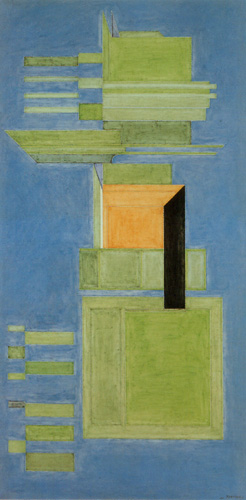Florence
I (gris-vert-bleu)
(Florence I, grey-green-blue)

1960, oil painting on canvas, 195 x 97 cm
Coll. Gaston Bertrand Foundation
N ° inv. 861
While some other artists consider geometric abstraction as the purpose of their work, Bertrand only considered it as a means allowing him to control the effusion of sensitiveness and to lend some coherence and solemnity to his work. For Bertrand, the post-war abstract revolution, which was decisive for many other artists, only acted as an encouragement to decant the reality and did not generate any radical change in the way he worked. A few months before he visited the Medicis Chapel, the painter explained his position: “An artist can perfectly create a major work based on reality but he will have to make choices among this reality. This choice is unavoidable in order to last over time and it must build upon abstraction, a form of abstraction which remains invisible for the non-initiated but provides rhythm, nobility and eternity to the work. There is a convergence with some immutable principles and particularly with logic and mathematics. These stimulating forces are always present in any good work”. As underlined in this statement, Bertrand was a classical artist and considered abstraction as a quest for harmony through mathematical equilibrium.
Knowing the historical antinomy between Florence and Venice – it is to say the antinomy between the shape and the colour – it is interesting to underline the prevalence of lines, plans, formal equilibrium and unity in Bertrand’s composition. Indeed, Bertrand was a rather “classical” painter and this clearly appears in the artist’s qualities and preferences: formal harmony prevailing over the search for expression, material and spiritual permanence of the accomplished work, the idea that art is transcendent and that a specific language must be used when dealing with the sublime.
Forty years after his trip to Italy, Gaston Bertrand stated: “In Italy, I obviously discovered the colour, its necessity and power, particularly in architecture”. The artist specified that the introduction of colours in his work was not directly inspired by the “local colour” of the Medicis Chapel. Actually, this clearly appears when comparing the very different harmonies of colours created by the painter for each of the four large vertical paintings directly inspired by the Medicis Chapel and entitled Florence.
In 1993, the Belgian Post issued, with seven and a half million copies, a fifteen francs Europa stamp showing a reproduction of this painting.